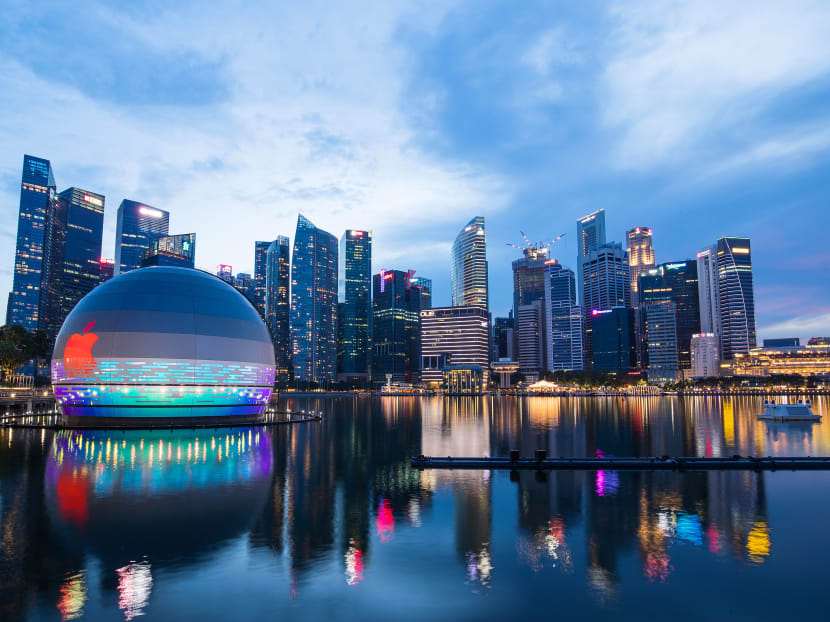S’pore economy grows 14.7% in Q2, MTI upgrades 2021 growth forecast amid recovery from pandemic slowdown
SINGAPORE — Singapore’s economy grew by 14.7 per cent in the second quarter of 2021 compared with the same period last year, though the economy remained slightly below pre-pandemic levels.

- MTI has upgraded the growth forecast for Singapore's economy to between 6 and 7 per cent
- The economy expanded by a “better-than-expected” 7.7 per cent in first half of 2021
- Nearly all sectors experienced growth in the second quarter when compared with the same period in 2020
- MTI expects Singapore’s recovery in external demand to remain “largely on track” for rest of the year
- But recovery of external-facing and domestic sectors is likely to be uneven
SINGAPORE — Singapore’s economy grew by 14.7 per cent in the second quarter of 2021 compared with the same period last year, though the economy remained slightly below pre-pandemic levels.
The strong growth in the latest quarter was largely due to the low base resulting from the Covid-19 circuit breaker measures in April and May last year that halted most economic activities and the low external demand during that period. This had resulted in a sharp 13.3 per cent contraction at the time, the Ministry of Trade and Industry (MTI) said on Wednesday (Aug 11).
The ministry revised its prediction for Singapore’s gross domestic product (GDP) to grow between 6 and 7 per cent this year, after an initial forecast of between 4 and 6 per cent growth.
This adjusted forecast is in line with the 6.5 per cent growth expected by economists, based on a survey by the Monetary Authority of Singapore (MAS) in June.
In absolute terms, however, GDP remained 0.6 per cent below its pre-pandemic level in the second quarter of 2019.
On a quarter-on-quarter seasonally adjusted basis, the Singapore economy contracted by 1.8 per cent in the latest quarter, reversing the 3.3 per cent expansion in the first quarter of the year.
However, the Singapore economy expanded by a better-than-expected 7.7 per cent in the first half of 2021 on a year-on-year basis.
At a press conference on Wednesday, Mr Gabriel Lim, MTI’s permanent secretary, said that since the ministry’s last media briefing in May, Covid-19 cases have continued to rise globally due to the Delta variant, and vaccination rates in key advanced economies have picked up, though those in the region have not been able to vaccinate their populations quickly.
“On balance, the recovery in external demand for Singapore for the rest of the year remains largely on track,” he said.
HOW THE DIFFERENT SECTORS PERFORMED
Nearly all sectors in the second quarter of this year outperformed when compared with the same period last year. This is largely attributed to the tight Covid-19 safety measures last April and May, creating a low base for comparison.
The manufacturing sector expanded by 17.7 per cent year-on-year, extending the 11.4 per cent growth recorded in the previous quarter. All clusters within the sector grew, with the transport engineering and precision engineering clusters growing the most.
The construction sector grew sharply by 106.2 per cent year-on-year, turning around from the 23.2 per cent contraction in the previous quarter as both public and private sector construction works expanded.
The wholesale trade sector expanded by 2.9 per cent compared with the same period last year. Growth in the sector was led by the machinery, equipment and supplies segment that saw strong wholesale sales of electronic components and telecommunications equipment and computers.
The retail trade sector grew by 50.7 per cent year-on-year, accelerating from the 1.6 per cent growth in January to March this year, largely due to the low base a year ago when sales were significantly lower because of the circuit breaker.
The transportation and storage sector grew by 20.9 per cent year-on-year, reversing the 15.8 per cent contraction in the preceding quarter. The strong growth comes off the back of a low base in the second quarter of 2020 when strict travel restrictions and circuit breaker were in place.
“As a whole, the sector’s value added remained 24 per cent lower than its pre-Covid level,” MTI said.
The accommodation sector expanded by 13.2 per cent year-on-year, easing from the 16.3 per cent growth in the preceding quarter. Growth during the quarter was supported by government and domestic tourism demand, though weak international visitor arrivals continued to weigh on the sector.
The circuit breaker last year also meant that the food-and-beverage (F&B) services sector in the second quarter this year grew by 36.7 per cent year-on-year, a turnaround from the 9.2 per cent contraction in the previous quarter. However, the value added by the sector remained 26 per cent below its pre-Covid level in 2019.
The information and communications sector grew by 9.6 per cent year-on-year, accelerating from the 6.8 per cent growth in the previous quarter.
The finance and insurance sector recorded a 9.1 per cent growth year-on-year, higher than the 5.7 per cent in the previous quarter. MTI said that the robust performance of the sector was supported by the banking segment, which grew due to the continued increase in net fees and commissions and interest income from loans.
The real estate sector expanded by 25.8 per cent year-on-year, while the professional services sector grew by 9.4 per cent compared with the same period last year.
Only the administrative and support services sector shrank in the second quarter, contracting by 1.3 per cent year-on year. The sector had shrank by 15.1 per cent in the previous quarter.
MTI said: “Within the sector, the rental and leasing segment shrank as travel restrictions adversely affected the rental and leasing of air transport equipment. This more than offset an expansion in the other administrative and support services segments.”
Other services industries expanded by 15.8 per cent year-on-year, primarily due to growth in the arts, entertainment and recreation segments, as well as the health and social services segments.
OUTLOOK FOR SINGAPORE
While Singapore’s recovery in external demand for the rest of the year remains largely on track, MTI said that the recovery of the various sectors is expected to remain uneven.
Growth prospects for outward-oriented sectors, such as manufacturing and wholesale trade, are expected to remain strong due to the rebound in global demand.
On the other hand, tourism and aviation-related sectors are projected to recover more slowly than previously expected, Mr Lim of MTI said.
“Even though domestic border restrictions may be eased towards the later part of the year, demand is not expected to return quickly as travel restrictions globally are likely to be lifted cautiously and global travel demand may also remain sluggish given the spread of more contagious strains of the virus,” he added.
Consumer-facing sectors, such as retail and F&B services, should start to recover as restrictions are eased over the course of the year and consumer sentiments improve in tandem with better labour market conditions.
While the construction sector as well as the marine and offshore engineering sectors are expected to recover compared with last year, MTI expects labour shortages due to prevailing border controls to weigh on the recovery of these sectors.
Asked about the outlook for the labour market, Mr Kenny Tan, divisional director of the Ministry of Manpower’s manpower planning and policy division, said that the heightened safety measures in the third quarter of this year are expected to have some impact.
Unemployment rates are expected to improve despite these measures, but mismatches between the expectations and skills of jobseekers and potential employers are likely to occur as a result of uneven recoveries in the domestic and outward-oriented sectors, he added.
Flagging the downside risks that could impede Singapore’s economic recovery, Mr Lim said that the Covid-19 situation has stabilised domestically, but the global trajectory of the pandemic continues to be a key risk.
“The ongoing economic recovery in advanced economies could be derailed if vaccination progress stalls due to vaccine hesitancy or if the efficacy of existing vaccines is weakened as a result of virus mutations or waning antibody levels,” he said.
Regional economies, who have had slow vaccination roll-outs, could also face an even sharper and more protracted period of slowdown if outbreaks occur, Mr Lim added.
Mr Edward Robinson, MAS’ deputy managing director and chief economist, said in response to questions that the current monetary policy “remains appropriate”. MAS had maintained its stance of zero appreciation of the Singapore dollar earlier this year and is scheduled to review its policy in October.
“The 6 to 7 per cent growth range (forecast) affirmed today continues to be consistent with the current policy stance… The exchange rate band provides the flexibility to accommodate orderly movements of the exchange rate in response to near term economic data,” Mr Robinson said.
MTI also said that Singapore’s own vaccination programme is continuing to “make good progress”.
“Barring a major setback in the global economy, the Singapore economy is expected to continue to see a gradual recovery in the second half of the year, supported in large part by outward-oriented sectors,” it added.








